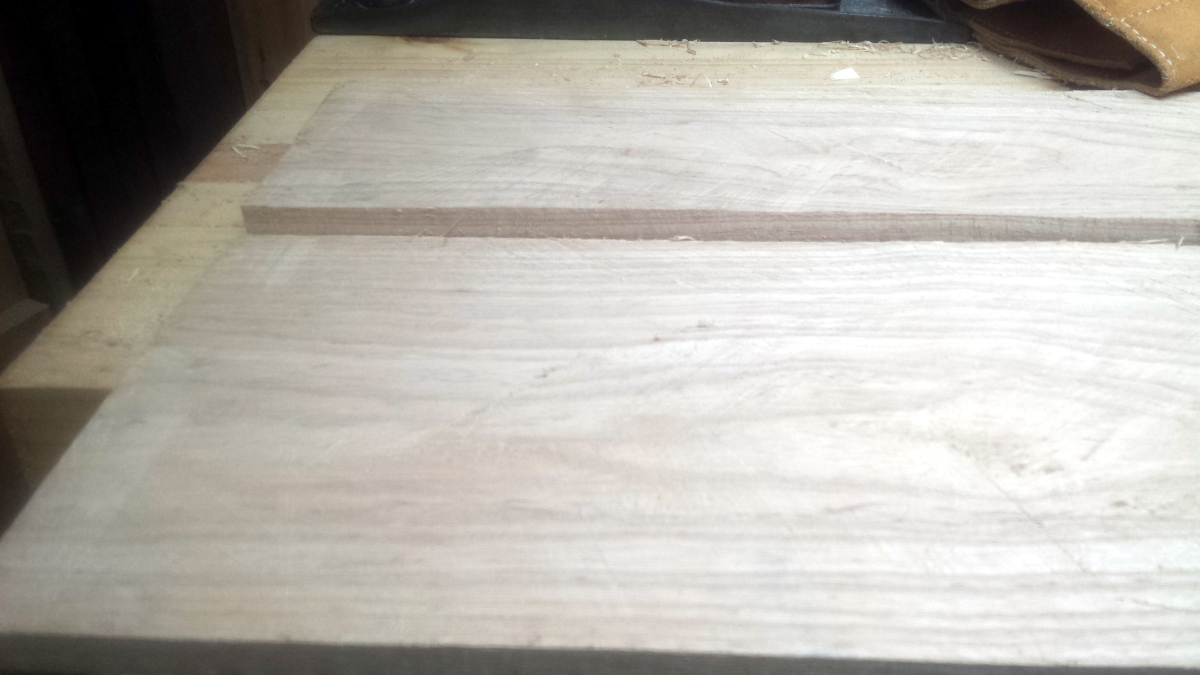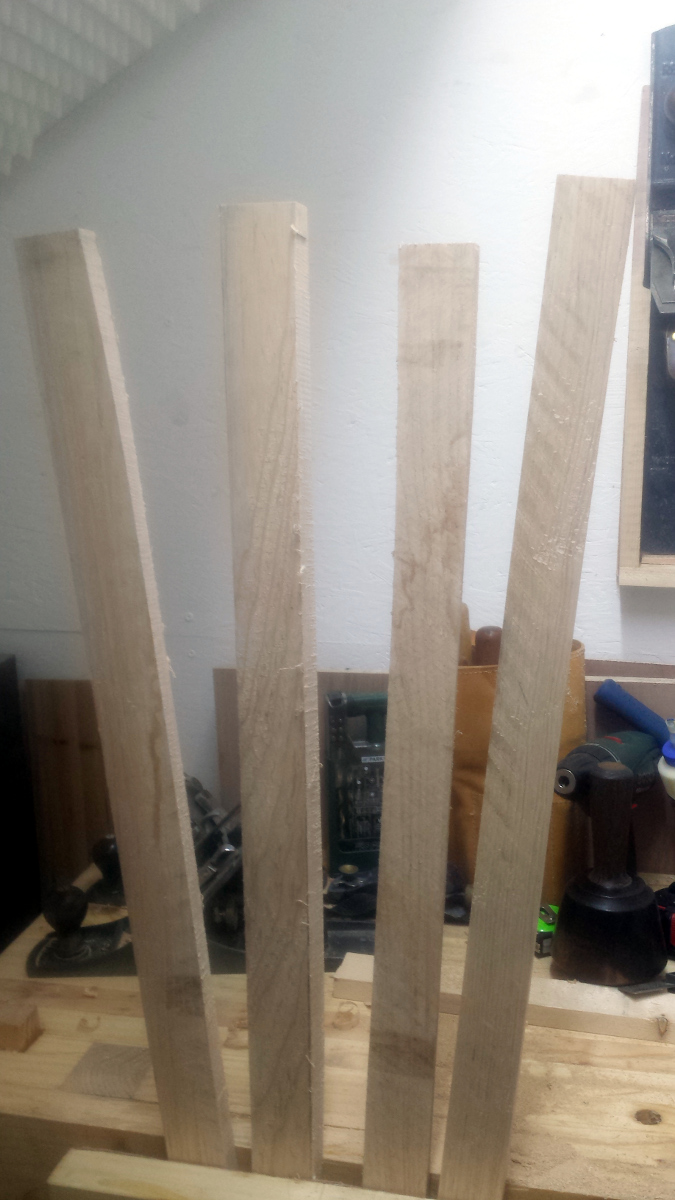I've posted something similar to this before, but some of the details are new so I hope it may be useful to others.
I am planning to make a fairly ambitious table soon, with some very nice wood that a generous forum member gave me. The thing is, I've not made anything much for quite a while, so I think I need a warming-up exercise first. So for now, I plan to make a little dovetailed box - a bread bin.
Several years ago at one of the MAC Timbers weekends, I bought this big lump of Alder:

It's used for domestic woodware as it has no taint. I believe it's nice and dry. It's about 2 5/8" thick and 46" long. The width varies but I shall deal with that when I edge-joint the boards later. I want some half inch boards, so I need to deep rip it into four pieces. Now I do know quite a few people with big beefy bandsaws that would do this job in a moment and have kindly offered me the use of them, but that wouldn't help me get back into wood working. And I'm not in a hurry. So here's how I set about it.
One of the biggest challenges is holding the work firmly. I'm sure the best option would be a pair of low saw horses, but the floor in my workshop is not flat enough to use them, so I don't have any. My best option is to hold it on the bench, in the vice.
I briefly tried holding it vertical and sawing straight ahead (cutting at right angles to the bench) like this:

but it was really difficult to get control - to make this cut

I was kneeling on the floor - no good!
I swapped round 90 degrees and put the wood in the vice, horizontally:

The far end needed some support, so I drilled a hole in the bench and popped a dowel in:

This worked well. The wood was solidly supported. The bench is a bit high though, so I raised the floor 4" by standing on this handy bit of oak, salvaged from someone chucking out their fire surround:

Progress was reasonable. After a little bit, I needed to wedge the cut open slightly:

Rather than turn round to the other end, as I got further along the cut, I wedged it with a piece of suitable thickness ply and cut on the other side of the vice:

Naturally, the right hand side needed a bit of support to do this. My bench does not have a fancy sliding deadman or selection of peg holes - but it does have a tool drawer under the top, with a handle which was just right for propping the board on!

And this was the eventual result:

I should add that I had marked a pair of lines about an eighth of an inch apart and sawed between them, swapping round to the opposite side of the wood every so often.
This is the saw I used - a 'second quality' line with 3 1/2 teeth per inch:



It cuts well - it's satisfying to see the progress with each stroke. The teeth on a rip saw work like tiny planes, shaving thin grooves down into the wood as you can see here:

From the timestamps on the photos, this first cut took about fifty minutes. Some of this was messing about with the camera, drinking a cup of coffee, etc, but most of it was just work.
Pleased with the way it went, I planed the sawn surfaces smooth, gauged the centre lines, and started on a second cut. Alder is a mild wood which planes easily - the gashes from inaccurate sawing soon disappeared:


This time I tried an alternative method of holding the wood in the vice, leaning over - a bit like the textbook way of sawing a tenon, but on a bigger scale:

This worked ok, but it still felt a bit high up and for the third cut I reverted to holding the wood horizontal where I could bear down on it better.
Some time (and some sweat) later, this was the result:

I'll sort out cutting these to length next, then plane them to final thickness as individual pieces to make the box. I will need to avoid a few flaws I have exposed, such as these knots


So, overall, would I recommend anyone to rip thin boards this way?
If you have a good bandsaw and just want to get on with a project in the quickest way, No.
But if you have the time, and need the exercise, go for it. You don't have to be super fit or fast if you can take your time. I enjoyed getting a bit more of a workout than I generally do and I think I have got to know how I can expect this particular bit of wood to behave. Of course, it's possible that the boards will all curl up like old sandwiches in the next few days, in which case I shall have learnt a different lesson.
Does anyone else do this sort of thing, by necessity or by choice?
I am planning to make a fairly ambitious table soon, with some very nice wood that a generous forum member gave me. The thing is, I've not made anything much for quite a while, so I think I need a warming-up exercise first. So for now, I plan to make a little dovetailed box - a bread bin.
Several years ago at one of the MAC Timbers weekends, I bought this big lump of Alder:

It's used for domestic woodware as it has no taint. I believe it's nice and dry. It's about 2 5/8" thick and 46" long. The width varies but I shall deal with that when I edge-joint the boards later. I want some half inch boards, so I need to deep rip it into four pieces. Now I do know quite a few people with big beefy bandsaws that would do this job in a moment and have kindly offered me the use of them, but that wouldn't help me get back into wood working. And I'm not in a hurry. So here's how I set about it.
One of the biggest challenges is holding the work firmly. I'm sure the best option would be a pair of low saw horses, but the floor in my workshop is not flat enough to use them, so I don't have any. My best option is to hold it on the bench, in the vice.
I briefly tried holding it vertical and sawing straight ahead (cutting at right angles to the bench) like this:

but it was really difficult to get control - to make this cut

I was kneeling on the floor - no good!
I swapped round 90 degrees and put the wood in the vice, horizontally:

The far end needed some support, so I drilled a hole in the bench and popped a dowel in:

This worked well. The wood was solidly supported. The bench is a bit high though, so I raised the floor 4" by standing on this handy bit of oak, salvaged from someone chucking out their fire surround:

Progress was reasonable. After a little bit, I needed to wedge the cut open slightly:

Rather than turn round to the other end, as I got further along the cut, I wedged it with a piece of suitable thickness ply and cut on the other side of the vice:

Naturally, the right hand side needed a bit of support to do this. My bench does not have a fancy sliding deadman or selection of peg holes - but it does have a tool drawer under the top, with a handle which was just right for propping the board on!

And this was the eventual result:

I should add that I had marked a pair of lines about an eighth of an inch apart and sawed between them, swapping round to the opposite side of the wood every so often.
This is the saw I used - a 'second quality' line with 3 1/2 teeth per inch:



It cuts well - it's satisfying to see the progress with each stroke. The teeth on a rip saw work like tiny planes, shaving thin grooves down into the wood as you can see here:

From the timestamps on the photos, this first cut took about fifty minutes. Some of this was messing about with the camera, drinking a cup of coffee, etc, but most of it was just work.
Pleased with the way it went, I planed the sawn surfaces smooth, gauged the centre lines, and started on a second cut. Alder is a mild wood which planes easily - the gashes from inaccurate sawing soon disappeared:


This time I tried an alternative method of holding the wood in the vice, leaning over - a bit like the textbook way of sawing a tenon, but on a bigger scale:

This worked ok, but it still felt a bit high up and for the third cut I reverted to holding the wood horizontal where I could bear down on it better.
Some time (and some sweat) later, this was the result:

I'll sort out cutting these to length next, then plane them to final thickness as individual pieces to make the box. I will need to avoid a few flaws I have exposed, such as these knots


So, overall, would I recommend anyone to rip thin boards this way?
If you have a good bandsaw and just want to get on with a project in the quickest way, No.
But if you have the time, and need the exercise, go for it. You don't have to be super fit or fast if you can take your time. I enjoyed getting a bit more of a workout than I generally do and I think I have got to know how I can expect this particular bit of wood to behave. Of course, it's possible that the boards will all curl up like old sandwiches in the next few days, in which case I shall have learnt a different lesson.
Does anyone else do this sort of thing, by necessity or by choice?




































